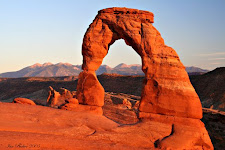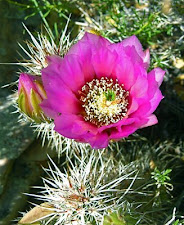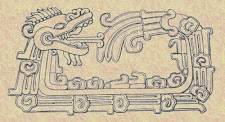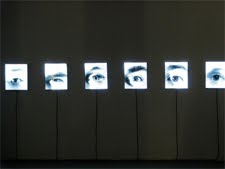I began the day exploring Badlands National Park - climbing up among the red and grey spires and eroded buttes and hiking through the grasslands. The Badlands are basically a less vivid, less mind bending version of Utah's Canyonlands. My cousin Jim tried to explain the geological difference to me and my understanding is that the sandstone of the Utah Canyonlands is much older and harder than the sedimentary rock of the Badlands. The young, less compact rock of the Badlands crumbles beneath your feet and turns, in places, to mud in the rain. It erodes faster and is unable to sustain the incredible shapes - the natural bridges, slot canyons and drip-castle hoodoos - of the Canyonlands. But it has some of these shapes - a few windows and mushroom-topped spires and jagged, dragon-toothed walls that look like mythical fortresses.
The Canyonlands may be more vast and startling - more exotic - but the Badlands have a beauty all their own and it is my impression that this beauty lies as much in the spaces in between the rocks - the grasslands - as in the rocks themselves. The Badlands are spread out the way the mountains in Montana are - eroded ridges rising here and there across the sunken plain. The Canyonlands feel more crowded - like the Colorado Rockies - a chaotic jumble of shapes and voids.
In the Badlands it’s easy to imagine the plains Indians riding horses and chasing Buffalo and setting up great tented camps in the valleys between the mountains. This is Sioux Country - Crazy Horse country. I might be over romanticizing the place, but I swear I can feel the Native spirits here. Thankfully, the National Park Service hasn't gone hog wild with paved roads and visitor centers. There are two small campgrounds, one paved loop road and a couple of long, meandering dirt roads. The rest is open space. Once off the road, you can walk for miles until you see nothing but grass and sky and distant ranges.
I was lucky to be here in the spring after a long, wet winter and the grass was vivid green sprinkled with yellow and purple wildflowers. A girl I met who grew up in the small town of Interior between the north and south sections of the park, told me that everything is usually brown by this time of year. And when I drove up out of the plains into the dark, wooded creases of the Black Hills to see Mount Rushmore, the wet spring was evident in the water rushing down in muddy torrents, sweeping branches and logs along with it.
Someone told me the Black Hills are the oldest Mountain Range in North America and, true or not, they are certainly far more impressive than their name suggests. They are definitely not hills, but mountains capped with crowns of granite and seams of silver and gold. Again, like the Badlands below, you can feel the history up here… that is until you turn the corner and enter Keystone, the tourist trap of a town below Mount Rushmore.
Keystone tries to capitalize on this history, literally… as in “capitalism.” It is a faux-frontier theme-town - a row of wooden, Hollywood-style western buildings inhabited by cheap motels and chain stores - Super 8, Subway, Dairy Queen - and t-shirt and bauble shops hawking plastic George Washington heads and fake mining memorabilia. Everything has terrible cartoony names like “Pick-axe Jack’s” and “Goldrush Trading Post” and is splashed with sensational slogans and advertisements - “stop here," “all you can eat,” “last chance,” “world famous.”
As I drove up the hill to the Mount Rushmore National Monument, I rolled up my windows to keep out the exhaust fumes from a line of tour buses.
I’ll admit that all of this may have predisposed me to be disappointed by the monument, but I’ve been to enough historic sites in this country and abroad to appreciate something for what it is. At the pyramids of Egypt I was mobbed by camel jockeys and hordes of children screaming “baksheesh! Backsheesh!” but the majesty of the pyramids outshone everything - they commanded my attention and pushed all of the sideshows and distractions into the background. Sadly I can’t say the same thing about Mount Rushmore.
I turned the corner near the top of the hill where the monument first comes into view. There were a couple of cars pulled to the side, to snap photos from this first vantage point. I pulled over too, but rather than hop out and take pictures, I just leaned on the steering wheel and stared and thought, “That’s it?”
I’m not oblivious to the technical challenges of creating a sculpture on such a large scale, especially in the 1930s, but, as would be expected, the renderings are a far cry from, say, Michaelangelo’s David. They look simplistic even slightly cartoonish - they are not awe inspiring. And they are not as large as I expected either - or at least not from a distance. I’m sure if you climb up on top of them, as some people do, they look much more impressive.
But this is the perspective they are intended to be seen from and they just don’t seem a fitting tribute to the men they represent. And in my mind the only man that even remotely has any kinship with the piece of land onto which they are carved is Teddy Roosevelt because he traveled throughout the west, founded the National Park System and was instrumental in the preservation of many of these lands. Even so, I wonder what he would think of the tasteless, unapologetic materialism of Keystone. I’m sure he’d identify much more with the open spaces of the Badlands or the untouched granite of the Cathedral Spires just a few miles away near Sylan Lake.
When I think of a fitting tribute to Washington, I think of the Potomac or the famous portrait that Dolly Madison rescued from White House when the British sacked the Capitol in 1812. When I think of Lincoln I think of Ford's Theater or Gettysburg and Jefferson, Monticello... certainly not a remote mountain in South Dakota.
Rather than inspire me, Mount Rushmore made me sad. Ninety-nine percent of the tourists who flock here will never hike up in these hills or fish these rivers or even stop to smell the birch, cottonwood and pine. They will arrive by bus or car, eat at Dairy Queen, snap a few photos and race down to Deadwood to play the slots. This place reminds me of a superhighway truck stop… only its worse because it brings superhighway culture into a place that wants nothing to do with it. It’s like painting an American flag on Yosemite’s Half Dome and building a Macdonald’s and Burger King at its base.
South Dakota State historian Doane Robinson conceived of the project to increase tourism to South Dakota and this he achieved spectacularly. Originally, he wanted to carve the nearby Cathedral Spires in the Needles (one of the Black Hills most stunning natural sites) into regional heroes including, ironically, Sioux Chief Red Cloud. Fortunately sculptor Gutzon Borglum found that site unsuitable and chose Rushmore instead (known as Six Grandfathers to the Sioux.) Borghum, a member of the Klu Klux Klan, also vetoed the Chief Red Cloud idea and chose the four presidents himself.
I challenge anyone to visit Rushmore and then immediately afterward drive the Needles Highway and hike up into the Cathedral Spires and tell me you are not grateful that these granite megaliths were spared.
The majesty and real history of this place speaks loudly enough for itself and there’s not a t-shirt, bauble or bumper sticker in the world that even comes close to conveying it.
After Mount Rushmore, I was prepared to be equally disappointed by Crazy Horse Mountain, but as I’d already driven this far and was less than a half hour away, I decided to go anyway. I’m glad I did.
First of all, the motivation behind Crazy Horse Mountain was not tourism, but genuine pride or as Chief Standing Bear wrote, so the white man knows that "the red man has heroes too." Secondly, Crazy Horse Mountain dwarves Mount Rushmore - the entire Rushmore Monument would fit easily into Crazy Horse’s hair - and, most importantly, Crazy Horse was a Lakota Sioux. He was from here. He was of this earth, literally, and a monument to him carved out of this earth is as fitting as Rushmore is odd.
When the polish engineer Korczak Ziolkowski, who was hired by local chiefs to build the monument, broke ground in 1948 there were actually nine Native Americans present who fought in the Battle of Little Bighorn and knew Crazy Horse. It was these people who helped Ziolkowski create a picture of Crazy Horse’s face because Crazy Horse never allowed anyone to photograph him.
The monument became Ziolkowski’s life’s work, but when he died in 1982 only a rough shape had been carved from the mountain. His wife Ruth still lives on the property and has carried on his vision. Crazy Horse’s face was finally completed in 1998.
The slow progress of the monument has been a source of disappointment and derision over the years, but now that the face is complete, I would argue that the rough shape of his torso atop a horse is even more effective than the ultimate goal of a perfect, smooth sculpture. It is the roughness of Crazy Horse that gives it authenticity. He looks like he is emerging from the mountain… part mountain and part man.
I don’t want to give the impression here that I am a revisionist or Native American sympathizer. I am aware of the nuance of history and the inevitability of the European westward expansion. It is naive to think that Native American tribes could have or even, given the chance, would have remained in their traditional state. But no one can deny that their defeat was bloody and humiliating. We decimated their long, proud culture in a matter of years. I truly feel they are a people to be admired and respected, just as I believe the European culture from which I come is to be admired and respected.
I am also aware that some Native Americans find Crazy Horse Monument offensive because a mountain was destroyed to create the image of a man - an act that is antithetical to Native beliefs.
My overall impression is mixed, but there is no doubt the monument is a huge, powerful accomplishment that exponentially outshines Rushmore. And in the end that’s the point really. We can’t rewrite history. We can’t purify a bloody past. But we can try to be as aware of our country’s true history as possible - from multiple perspectives - and, if nothing else, Crazy Horse Mountain forces us to think and remember. That is what it was intended to do. In those terms, it is a great success.
My next stop was a site even more massive and impressive than Crazy Horse and also a site sacred to Native Americans. But it was not shaped by the hands of men even if it seems impossible that it was created by nature. It is so unnatural looking that its easy to see how Europeans twisted its Native American name (Bear Lodge) into Devils Tower. But I climbed up to its vertical walls and laid against its ribs and I promise you there is nothing devlish about it. It emanates a deep penetrating calm - the primordial violence that formed it captured in suspended animation like the earth's beating heart has been stilled and laid bare.
And that really isn't far from the truth. The Devils Tower formed underground, lava pushing upwards in tubes, cooling and forming a plug. Over thousands of years the earth around the plug eroded away leaving it exposed as the tower we see today.
The best way to approach the tower is through the small town of Hulett on Rte 24. (See the slideshow below.) If you are on Interstate 90, exit in Spearfish and take the 85 North to Belle Fourche. Then take the 34 West into Wyoming. It eventually turns into the 24. This is beautiful country - crumbling terraces of red rock, stands of pine and cottonwood along the rivers and hillsides, dirt roads disappearing into meadows... it is a windows down, breath of fresh air.
After hiking up to the tower, I drove back into Hulett and went north on 112 and then west on 212. The Montana border is only thirty miles north of Hulett and there is no denying this is Big Sky Country. The intimacy and small scale of the river valley along the 24 is replaced with great grassy expanses and rock escarpments. The cows here are spread so far and wide they look like crows standing in the grass.
The day had one last surprise for me. Just before sunset, in a light drizzle, I arrived at the junction of the 212 and the I-90 and found myself next to the Little Bighorn Battlefield where, on June 25-26, 1876 Crazy Horse and Sitting Bull and others chiefs of the Lakota-Cheyenne alliance defeated and killed General George Custer. It was a decisive and bloody victory for the Native Americans, but a pyrhic victory... and they knew it. The US Cavalry soon reinforced itself and mounted another offensive against the tribes. Crazy Horse Surrendered a year later and Sitting Bull fled to Canada. The battle was part of a larger conflict called the Sioux or Black Hills War - the final, full scale Native resistance to US westward expansion.
Understandably, for a United States National Monument, the battlefield is sympathetic to Custer and the hundreds of US Cavalrymen who died at Little Bighorn. There is a monument to Custer on the hill where his famous Last Stand took place and smaller gravestones marking the spots where his men fell. Custer's Hill overlooks the entire battlefield and river where the Sioux-Cheyenne camp was located. It is not hard to imagine a great battle raging here and especially standing alone there in the misty dusk it left me feeling awe-inspired and sad.
I can only describe my feelings as that of someone who loves the western United States very much - who has spent decades hiking, camping and skiing here. I like to think that I belong here.... I feel that I belong here, but I am aware that my presence is the result of a very violent history and that there are others who might regard my presence as intrusive. I respect this opinion, but, again, I believe the world was headed towards an inevitable change and the Americas had no chance of remaining isolated. They were going to be absorbed into the global community one way or another. The United States is not, in a longshot, the worst possible outcome for North America. Native peoples have been treated poorly around the world. We are not exceptional in this way. I can only hope going forward that we continue to preserve the beautiful natural landscapes and resources that make this country and continent so special and diverse and that one day we will share a common, proud legacy.
For now there are still the ghosts of Little Bighorn and Wounded Knee to be reckoned with.
travel, philosophy, art, culture
Blog Archive
Music
Video: Derek Paravicini - Musical Genius
Video: M Ward - Chinese TranslationMusic
Video: Jennifer Grout - sings Umm Kulthum on "Arabs Got Talent"
Photos
Baja Surf Trip
Topanga Canyon, Fall 2010
Devils Tower Sequence
Spring/Summer 2010 Travel Pics
More Travel Pics
My Summer Home in Oregon
Clark Little Surf Photography
Videos
Music: M Ward - Chinese Translation
Interview: linguist David Harrison
Music: Derek Paravicini - Musical Genius
Video: Derek Paravicini - Musical Genius
Video: M Ward - Chinese TranslationMusic
Video: Jennifer Grout - sings Umm Kulthum on "Arabs Got Talent"
Photos
Baja Surf Trip
Topanga Canyon, Fall 2010
Devils Tower Sequence
Spring/Summer 2010 Travel Pics
More Travel Pics
My Summer Home in Oregon
Clark Little Surf Photography
Videos
Music: M Ward - Chinese Translation
Interview: linguist David Harrison
Music: Derek Paravicini - Musical Genius
Video: One in 8 Million: photo essays of individual New Yorker's lives (from The New York Times)
Music: Jennifer Grout - Sings Umm Kulthum on "Arabs Got Talent"
Poetry
Music: Jennifer Grout - Sings Umm Kulthum on "Arabs Got Talent"
Poetry
Denice Cacace - Haiku
John Keats - Bright Star
John Updike - A Rescue
Billy Collins - Thesaurus
John Dunn - Handwritten Letter
John Dunn - Gettin' All Poetiky
Johann Wolfgang Von Goethe - The Erl-King
Books
Edward Abbey - Manhattan Twilight, Hoboken Night (from The Journey Home)
Don Delillo - Underworld
Jorge Luis Borges - The Secret Miracle (From Labyrinths)
Robert Penn Warren - All The King's Men
John Keats - Bright Star
John Updike - A Rescue
Billy Collins - Thesaurus
John Dunn - Handwritten Letter
John Dunn - Gettin' All Poetiky
Johann Wolfgang Von Goethe - The Erl-King
Books
Edward Abbey - Manhattan Twilight, Hoboken Night (from The Journey Home)
Don Delillo - Underworld
Jorge Luis Borges - The Secret Miracle (From Labyrinths)
Robert Penn Warren - All The King's Men
Essays
Multiple authors: Fifteen Unforgettable Movie Moments (from Salon)
John Dunn: LA Love Letter
John Dunn: Impressions of the Badlands, Black Hills and Little Bighorn
Matt Power: Mississippi Drift - River Vagrants in the Age of Wal-Mart (from Harper's)
Kevin Fedarko: High in Hell - An Epic Drug Fueled Travel Story (from Esquire)
John Dunn: Getting Myspaced - Self Discovery Through Social Networking
John Bradley: Golf Bro Will Mackenzie - Making it Cool to Watch Golf Again (from Outside)
John Dunn: Golf Course Review: Old Macdonald - Doak's Encore at Bandon
John Dunn: LA Love Letter
John Dunn: Impressions of the Badlands, Black Hills and Little Bighorn
Matt Power: Mississippi Drift - River Vagrants in the Age of Wal-Mart (from Harper's)
Kevin Fedarko: High in Hell - An Epic Drug Fueled Travel Story (from Esquire)
John Dunn: Getting Myspaced - Self Discovery Through Social Networking
John Bradley: Golf Bro Will Mackenzie - Making it Cool to Watch Golf Again (from Outside)
John Dunn: Golf Course Review: Old Macdonald - Doak's Encore at Bandon

"A weird, lovely, fantastic object out of nature like Delicate Arch has the curious ability to remind us - like rock and sunlight and wind and wildflowers - that out there is a different world, older and greater and deeper by far than ours, a world which sustains the little world of man as sea and sky surround and sustain a ship. For a little while we are again able to see, as the child sees, a world of marvels. For a few moments we discover that nothing can be taken for granted, for if this ring of stone is marvelous, then all which shaped it is marvelous, and our journey here on Earth, able to see and touch and hear in the midst of tangible and mysterious things-in-themselves, is the most strange and daring of all adventures." - Edward Abbey, Desert Solitaire

"It is impossible to convey the life-sensation of any given epoch of one's existence - that which makes its truth, its meaning, its subtle penetrating essence. It is impossible. We live, as we dream, alone." - Joseph Conrad, Heart of Darkness

"Full circle from the tomb of the womb to the womb of the tomb we come, an ambiguous, enigmatical incursion into a world of solid matter that is soon to melt from us like the substance of a dream." - Joseph Campbell, Hero with a 1000 Faces

"The cactus of the high desert is a small grubby, obscure and humble vegetable associated with cattle dung and overgrazing, interesting only when you tangle with it the wrong way. Yet from this nest of thorns, this snare of hooks and fiery spines, is born once each year a splendid flower. It is unpluckable and except to an insect almost unapproachable, yet soft, lovely, sweet, desirable, exemplifying better than the rose among thorns the unity of opposites" - Edward Abbey, Desert Solitaire

"He knew that the very memory of the piano falsified still further the perspective in which he saw the elements of music, that the field open to the musician is not a miserable stave of seven notes, but an immeasurable keyboard on which, here and there only, separated by the thick darkness of its unexplored tracts, some few of the millions of keys of tenderness, of passion, of courage, of serenity, which compose it, each one differing from all the rest as one universe differs from another, have been discovered by a few great artists who do us all a service, when they awaken in us the emotion corresponding to the theme they have discovered, of showing us what richness, what variety lies hidden, unknown to us, in that vast, unfathomed and forbidden night of our soul." - Marcel Proust, Swann's Way

"Perhaps it is not-being that is the true state, and all our dreams of life are inexistent. We shall perish, but we have as hostages these phrases of music, these divine captives who will follow and share our fate. And death in their company is somehow less bitter, less inglorious, perhaps even less probable." - Marcel Proust, Swann's Way

"The creature was very young. He was alone in a dread universe. I crept on my knees and crouched beside him. It was a small fox pup from a den under the timbers who looked up at me. God knows what had become of his brothers and sisters. His parents must not have been home from hunting. He innocently selected what I think was a chicken bone from an untidy pile of splintered rubbish and shook it at me invitingly... the universe was swinging in some fantastic fashion around to present its face and the face was so small that the universe itself was laughing.
It was not a time for human dignity. It was a time only for the careful observance of amenities written behind the stars. Gravely I arranged my forepaws while the puppy whimpered with ill-concealed excitement. I drew the breath of a fox's den into my nostrils. On impulse, I picked up clumsily a whiter bone and shook it in teeth that had not entirely forgotten their original purpose. Round and round we tumbled and for just one ecstatic moment I held the universe at bay by the simple expedient of sitting on my haunches before a fox den and tumbling about with a chicken bone. It is the gravest, most meaningful act I shall ever accomplish, but, as Thoreau once remarked of some peculiar errand of his own, there is no use reporting it to the Royal Society." - Loren Eiseley, The Star Thrower
It was not a time for human dignity. It was a time only for the careful observance of amenities written behind the stars. Gravely I arranged my forepaws while the puppy whimpered with ill-concealed excitement. I drew the breath of a fox's den into my nostrils. On impulse, I picked up clumsily a whiter bone and shook it in teeth that had not entirely forgotten their original purpose. Round and round we tumbled and for just one ecstatic moment I held the universe at bay by the simple expedient of sitting on my haunches before a fox den and tumbling about with a chicken bone. It is the gravest, most meaningful act I shall ever accomplish, but, as Thoreau once remarked of some peculiar errand of his own, there is no use reporting it to the Royal Society." - Loren Eiseley, The Star Thrower

The moment I stepped out the front door I was faced again with Manhattan. There it was, oh splendid ship of concrete and steel, aluminum, glass and electricity, forging forever up the dark river. (The hudson - like a river of oil, filthy and rich, gleaming with silver lights.) Manhattan at twilight: floating gardens of tender neon, the lavender towers where each window glittered at sundown with reflected incandescence, where each crosstown street became at evening a gash of golden fire, and the endless flow of the endless traffic on the West Side Highway resembled a luminous necklace strung round the island's shoulders. - Edward Abbey, Manhattan Twilight, Hoboken Night

Sometimes I see something so moving I know I'm not supposed to linger. See it and leave. If you stay too long, you wear out the wordless shock. Love it and trust it and leave. - Don Delillo, Underworld

Yes. Because they were human men. They were trying to write down the heart's truth out of the heart's driving complexity, for all the complex and troubled hearts which would beat after them. - William Faulkner, The Bear

He picks up speed and seems to lose his gangliness, the slouchy funk of hormones and unbelonging and all the stammering things that seal his adolescence. He is just a running boy, a half-seen figure from the streets, but the way running reveals some clue to being, the way a runner bares himself to consciousness, this is how the dark-skinned kid seems to open to the world, how the bloodrush of a dozen strides bring him into eloquence. - Don Delillo, Underworld

If somewhere beneath the blood, the past must beat in me to make a rhythm of survival for itself - to go on as this half-life which echoes as a second pulse inside the ticking moments of my existence - if this is what must be, why is the pattern of remembered instants so uneven, so gapped and rutted and plunging and soaring? I can only believe it is because memory takes its pattern from the earliest moments of the mind, from childhood. And childhood is a most queer flame-lit and shadow-chilled time. - Ivan Doig, This House of Sky

The storm front towered above them and the wind was cool on their sweating faces. They slumped bleary-eyed in their saddles and looked at one another. Shrouded in the black thunderheads the distant lightning glowed mutely like welding seen through foundry smoke. As if repairs were under way at some flawed place in the iron dark of the world. - Cormac McCarthy, All the Pretty Horses
.jpg)
Men believe the cure for war is war as the curandero prescribes the serpent's flesh for its bite. - Cormac McCarthy, All the Pretty Horses

Big production, no story, as they say around the movie lots. I guess Sylvia is happy enough, though not necessarily with me. In our circle that's not too important. There's always something to do if you don't have to work or consider the cost. It's no real fun, but the rich don't know that. They never had any. They never want anything very hard except maybe somebody else's wife and that's a pretty pale desire compared to the way a plumber's wife wants new curtains for the living room. - Raymond Chandler, The Long Goodbye
The charged atmosphere made every little thing stand out as a performance, a movement distinct and vastly important. It was one of those hypersensitive moments when all your automatic movements, however long established, however habitual, become separate acts of will. You are like a man learning to walk after polio. You take nothing for granted, absolutely nothing at all. - Raymond Chandler, The Long Goodbye
We live entirely, especially if we are writers, by the imposition of a narrative line upon disparate images, by the "ideas" with which we have learned to freeze the shifting phantasmagoria which is our actual experience. - Joan Didion, The White Album

Seattle rain smells different from New Orleans rain... New Orleans rain smells of sulfur and hibiscus, trumpet metal, thunder and sweat. Seattle rain, the widespread rain of the Great Northwest, smells of green ice and sumi ink, of geology and silence and minnow breath. - Tom Robbins, Jitterbug Perfume

"There was a special pallor in the face of the New York emigres. Lasher and Grappa in particular. They had the wanness of obsession, of powerful appetites confined to small spaces. Murray said that Eliot Nasher had film noir face. His features were sharply defined, his hair perfumed with some oily extract. I had the curious thought that these men were nostalgic for black-and-white, their longings dominated by achromatic values, personal extremes of postwar urban gray." - Don Delillo, White Noise
















No comments:
Post a Comment